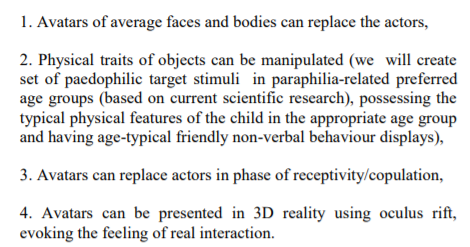Exploring the Pathways of Adaptation an Avatar 3D Animation Procedures and Virtual Reality Arenas in Research of Human Courtship Behaviour and Sexual Reactivity in Psychological Research
PubDate: Nov 2016
Teams: Charles University in Prague;University of Nottingham
Writers: Jakub Binter, Kateřina Klapilová, Tereza Zikánová, Tommy Nilsson, Klára Bártová, Lucie Krejcová, Renata Androvicová, Jitka Lindová, Denisa Prušová, Timothy Wells, Daniel Riha

Abstract
There are many reasons for utilising 3D animation and virtual reality in sexuality research. Apart from providing a mean with which to (re)experience certain situations there are four main advantages: a) bespoke animated stimuli can be created and customized, which is especially important when researching paraphilia and sexual preferences, b) stimulus production is less expensive and easier to produce compared to real world stimuli, c) virtual reality allows us to capture data such as physiological reasons to stimuli, that we would not be able to otherwise (without resorting to self-report measures which are especially problematic in this research domain), d) ethical, legal, and health and safety issues are less complex since neither physical nor psychological harm is caused to animated characters allowing for the safe presentation of stimuli involving vulnerable targets. The animation sub-group has been exploring so far several production quality levels and various animation procedures in a number of available software. The aim is to develop static as well as dynamic, interactive sexual stimuli for sexual diagnostic and therapeutic purposes. We are aware of number of ethical issues related to the use of virtual reality in proposed research are analysed in this chapter.

